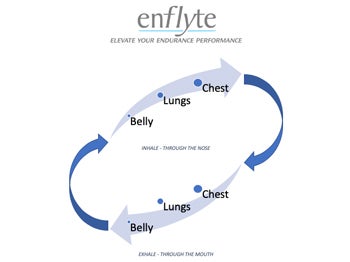New perk! Get after it with local recommendations just for you. Discover nearby events, routes out your door, and hidden gems when you sign up for the Local Running Drop.
The fitness test to join the elite ranks of the Navy SEAL program makes a sprint triathlon look paltry in comparison: at minimum, prospective candidates must complete a 1.5-mile run in boots and pants, 500-yard breast- or side-stroke swim, 50 pushups, 10 consecutive pull-ups, and 50 sit-ups, all with tight time requirements.But fitness is only part of the equation. Being able to keep cool in every imaginable setting—from interrogation to gunfire—is crucial for a SEAL. To accomplish this, they undergo another kind of training known as breath work, which slows the heartbeat, lowers blood pressure, and decreases feelings of anxiety or stress.
But this practice isn’t exclusive to SEALs. In fact, breath work can benefit triathletes of all levels, says Christina M. Roberts of EnFlyte Coaching:
“Sometimes, we encounter stressors on race day, such as fear of DNF or missing the goal or anxiety about open water. Our perceived threat of the situation—‘It’s going to be hard’ or ‘I’m going to DNF’—can create a physical response in the body that makes our breathing shallow, elevates heart rate and blood pressure, tenses muscle, and even creates gastrointestinal distress.”
By breathing with purpose, athletes can regulate heart rate, which in decreases feelings of anxiety and stress. Breath work also engages the parasympathetic nervous system, which is designed to kick in when the body experience stress.
“There are so many different styles to breath work,” explains Roberts. “It’s a great daily practice and doesn’t have to be time consuming.”
To train (your breathing) like a SEAL, Roberts recommends the following exercises:
Daily Breath Work
The two following breathing exercises are best done regularly in a quiet place, typically seated.
Belly Breathing (a.k.a. “Circle Breath”)
- Settle into your seat, relax your shoulders, ease your jaw.
- Place a hand on your belly or heart to feel the movement of the breath.
- Inhale through the nose – fill the belly and lungs completely. Chest lifts.
- Exhale through the mouth – slowly blow the air out, letting everything deflate like a balloon. Lips are pursed as if blowing out through a straw.
- Repeat for 10 – 20 complete breaths

Box Breathing (or “Square Breathing”)
- For ease of counting, connect all your fingertips. Hands can rest in your lap.
- Inhale through the nose – same as above for 4 counts (left hand begins).
- Hold the breath for 4 counts (right hand counts down).
- Exhale through the mouth – same as above for 4 counts (left hand counts thumb to pinky).
- Hold the exhale for 4 counts (right hand counts down pinky to thumb).
- Repeat for 5 – 10 rounds.

Breath Work While Training
On the Run
- Best practiced during a warm up or cool down.
- Settle into your warm up/cool down pace.
- Inhale through the nose for 2 counts; exhale through the nose for 2 counts.
- These counts should be paired with your cadence.
- For example, Right foot strike/left foot strike is one count
- Modifications:
- This same exercise can be done on the bike, preferably during longer stretches of effort (such as a long, flat straightaway or a steady-state effort on the trainer).
- As you get more experience with this practice, try during the main set of your workout, too.
- As pace increases, inhale through the nose for 2 counts; exhale through the nose for 1 count.
- Try breathing through your nose the entire time.
Breath Work In Competition
Centering
- This is a great practice before getting into your wetsuit and/or while waiting for your swim wave to start.
- Stand tall, feeling grounded.
- Breathe through the nose, filling the belly and lungs completely, for 5 – 10 rounds. Repeat if needed.
- If at any point during a competition you need to regroup, get a few belly breaths initiated to center yourself.
